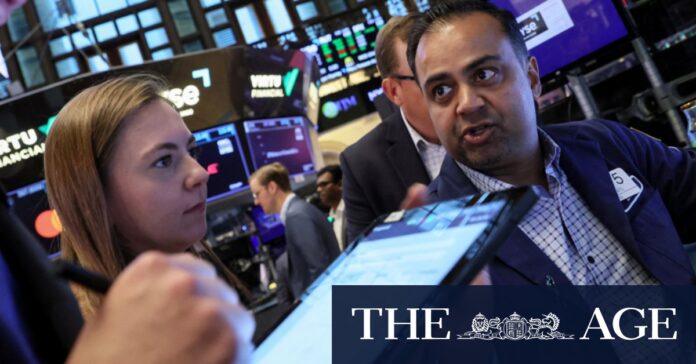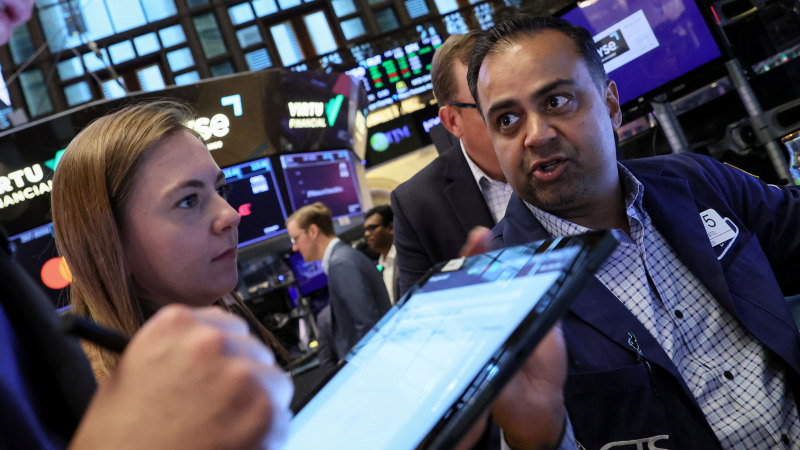[ad_1]
The S&P 500 closed 1.2 per cent lower, following up on its 1.6 per cent loss from last week, which was its worst since October. The Dow Jones lost 0.7 per cent and the Nasdaq composite shed 1.8 per cent lower.
The S&P 500 had been up as much as 0.9 per cent earlier in the day, rising as oil prices eased with hopes that international efforts to calm escalating tensions in the Middle East may help. But Treasury yields also spurted higher following the latest report on the US economy to blow past expectations.
Loading
The economy and financial markets are in an awkward phase where such strength raises traders’ hopes for growing profits at companies but also hurts expectations for easier interest rates coming from the Federal Reserve. They’re the two main levers that set stock prices, and they’re simultaneously pulling Wall Street in different directions.
Traders want lower interest rates, which can give the overall economy a boost, and much of the US stock market’s run to records recently was built on such expectations.
But strong reports like the one on Monday’s, which showed US shoppers increased their spending at retailers last month by much more than economists expected, have traders broadly forecasting just one or two cuts to rates this year, according to data from CME Group. That’s down from expectations for six or more cuts at the start of this year. Some traders are bracing for potentially no cuts.
High interest rates and bond yields hurt prices for all kinds of investments, particularly those that look expensive or those that compete for the same kinds of investors as bonds do.
As a result, real-estate investment trusts fell to some of Monday’s sharpest losses in the stock market. When bonds are paying higher yields, they peel away investors who might otherwise be interested in the relatively big dividends that real-estate stocks pay. High rates can also pressure real estate prices broadly.
Loading
More influential was weakness for Big Tech stocks. Apple dropped 2.2 per cent, Nvidia fell 2.5 per cent and Microsoft sank 2 per cent. They’ve been past beneficiaries of low interest rates and often feel pressure when yields are rising. Because they’re also the largest stocks on Wall Street, their movements carry extra weight on the S&P 500 and other indexes.
Nvidia, for example, swung from an early gain of nearly 2.8 per cent to its loss in the afternoon and was the third-largest force weighing on the S&P 500.
Helping to keep the losses in check were some financial companies, which reported encouraging profit for the start of the year. The pressure is on companies broadly to deliver fatter profits because interest rates looks so much less likely to offer support in the near term.
Goldman Sachs rose 2.9 per cent following its earnings report.
Charles Schwab rose 1.7 per cent after also edging past analysts’ forecasts for its profit last quarter.
In the oil market, benchmark US crude was holding steady at $US85.67 per barrel. Brent crude, the international standard, fell 0.5 per cent to $US89.99 per barrel as political leaders around the world urged Israel not to retaliate after Iran’s attack on Saturday involving hundreds of drones, ballistic missiles and cruise missiles.
Financial markets had been nervous heading into the weekend. The worry was that an attack by Iran could widen Israel’s war with Hamas and ultimately constrict the flow of crude oil. But Israel said 99 per cent of the drones and missiles were intercepted as diplomats urged a de-escalation and the US administration made clear it did not support a wider war with Iran.
This year’s jump in oil prices has been raising worries about a knock-on effect on inflation, which has remained stubbornly high. After cooling solidly last year, inflation has consistently come in above forecasts in each month so far of 2024.
Loading
“If inflation is sticky because of momentum in the economy, that’s not necessarily bad for stocks,” Bank of America strategists led by Ohsung Kwon wrote in a BofA Global Research report. “But stagflation is,” referring to the painful combination of a stagnating economy and high inflation.
Strategists at Wells Fargo Investment Institute raised their forecast for where the S&P 500 could end this year in part because the resilience of the US economy pushed them to upgrade their forecasts for it. While they expect the market to be choppy following its big gains since October, they say a growing US economy should drive sales for companies.
The yield on the 10-year Treasury rose to 4.63 per cent from 4.52 per cent late on Friday. The two-year yield, which moves more closely with expectations for action by the Federal Reserve, climbed to 4.93 per cent from 4.89 per cent.
In other international stock markets, indexes were mixed across Europe. They struggled more in Asia, where Hong Kong’s Hang Seng and Tokyo’s Nikkei 225 both fell 0.7 per cent.
With AP
The Market Recap newsletter is a wrap of the day’s trading. Get it each weekday afternoon.
[ad_2]
Source link



